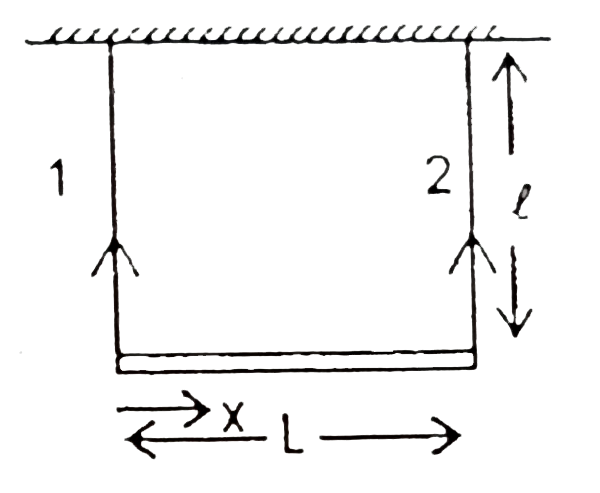What is the ratio of the number of loops in a Meldes' string, when the string vibrates in longitudinal mode and transverse mode.
To solve the problem of finding the ratio of the number of loops in a Melde's string when it vibrates in longitudinal mode versus transverse mode, we can follow these steps:
Step 1: Understand the Modes of Vibration
- In longitudinal mode, the vibrations occur along the length of the string, creating compressions and rarefactions.
- In transverse mode, the vibrations occur perpendicular to the length of the string, creating loops.
Step 2: Define the Variables
- Let L be the number of loops formed in the longitudinal mode.
- Let T be the number of loops formed in the transverse mode.
Step 3: Establish the Relationship
- The relationship between the number of loops in longitudinal and transverse modes can be derived from the properties of waves. In general, for a given length of the string, the number of loops in transverse mode is twice that of the longitudinal mode.
Step 4: Set Up the Ratio
- From the relationship established, we can express the ratio of the number of loops as:
LT=12
Step 5: Calculate the Ratio
- Rearranging gives us:
T=2L
- Therefore, the ratio of the number of loops in longitudinal mode to transverse mode is:
LT=L2L=12
Conclusion
- The ratio of the number of loops in longitudinal mode to transverse mode is 12.
---
- In longitudinal mode, the vibrations occur along the length of the string, creating compressions and rarefactions.
- In transverse mode, the vibrations occur perpendicular to the length of the string, creating loops.
- Let L be the number of loops formed in the longitudinal mode.
- Let T be the number of loops formed in the transverse mode.
- The relationship between the number of loops in longitudinal and transverse modes can be derived from the properties of waves. In general, for a given length of the string, the number of loops in transverse mode is twice that of the longitudinal mode.
Step 4: Set Up the Ratio
- From the relationship established, we can express the ratio of the number of loops as:
LT=12
- Rearranging gives us:
T=2L
- Therefore, the ratio of the number of loops in longitudinal mode to transverse mode is:
LT=L2L=12
- The ratio of the number of loops in longitudinal mode to transverse mode is 12.
Topper's Solved these Questions
- WAVESBOOK - ICSECHAPTER - WAVESEXERCISE - Doppler Effect, Musical, Sound, Noise
26 Videos
- WAVESBOOK - ICSECHAPTER - WAVESEXERCISE - Very Short Answer Questions
14 Videos
- WAVESBOOK - ICSECHAPTER - WAVESEXERCISE - Short Answer Questions.
32 Videos
- VECTORS SCALARS ELEMENTARY CALCULUS BOOK - ICSECHAPTER - VECTORS SCALARS ELEMENTARY CALCULUS EXERCISE - UNSOLVED PROBLEMS
79 Videos
Similar Questions
A string of mass per unit length μ is clamped at both ends such that one end of the string is at x=0 and the other is at x=L. When string vibrates in fundamental mode, amplitude of the midpoint of string is a and tension in the string is F. Find the total oscillation energy (in J) stored in the string. (Use L=1 m, F = 10N, a = 1/pi m).

View SolutionTwo strings of the same length but different mass per unit length are used to suspend a rod whose density varies as ρ=ρ0[1+αx] as shown in the figure. The frequency of standing waves produced in the string is in the ratio n:1, when both the strings are vibrating in their fundamental mode. If the mass per unit length of string (l) is μ0, calculate the mass per unit length of the other string.

View Solution
Knowledge Check
A string of length 2 m is fixed at both ends. If this string vibrates in its fourth normal mode with a frequency of 500 Hz, then the waves would travel on its with a velocity of
A125 ms−1B250 ms−1C500 ms−1D1000 ms−1The speed of transverse wave on a stretched string is
Adirectly proportional to the tension in the stringBdirectly proportional to the square root of the tensionCinversely proportional to liveDinversely proportional to sqyare of tension
A string of length L and mass M hangs freely from a fixed point . Calculate the velocity of the transverse wave along the string at any position.
(b)Calculate time taken by a transverse pulse to traverse the string.
View SolutionDraw a diagram to show the various modes of vibration of a stretched string.
View SolutionA string vibrates in its first normal mode with a frequency of 220 vibrations /s. The vibrating segment is 70.0 cm long and has a mass of 1.20g.
(a) Find the tension in the string.
(b) Determine the frequency of vibration when the string vibrates in three segments.
View SolutionA piano string 1.5m long is made of steel of density 7.7×103kg/m3andγ=2×1011N/m2. It is maintained at a tension which produces an elastic strain of 1% in the string . What is the fundamental frequency of transverse vibration of the string ?
View SolutionA piano string 1.5m long is made of steel of density 7.7×103kg/m3andγ=2×1011N/m2. It is maintained at a tension which produces an elastic strain of 1% in the string . What is the fundamental frequency of transverse vibration of the string ?
View SolutionIn Melde's experiment , when a string is stretched by a piece of glass it vibrates with 7l∞ps . When the glass piece is completely immersed in water the string vibrates in 9l∞ps. What is the specific gravity of glass ?
View Solution
